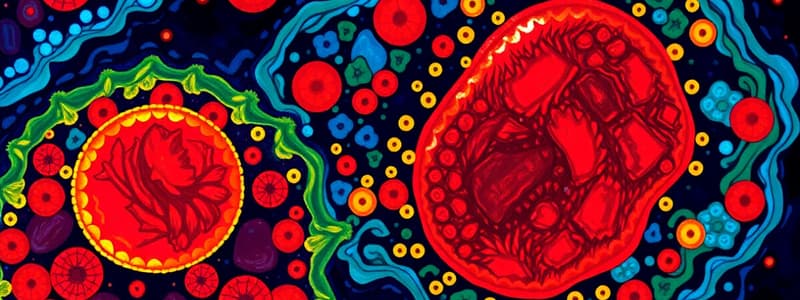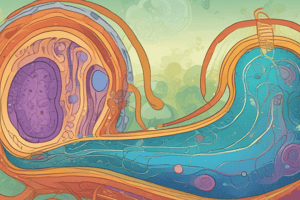Podcast
Questions and Answers
What is the primary function of the oxidative enzymes attached to the shelves of the inner mitochondrial membrane?
What is the primary function of the oxidative enzymes attached to the shelves of the inner mitochondrial membrane?
- To store energy in the form of lipids
- To synthesize structural proteins
- To catalyze the oxidation of nutrients (correct)
- To facilitate DNA replication
What substance is synthesized from the energy released during the oxidation of nutrients in the mitochondrion?
What substance is synthesized from the energy released during the oxidation of nutrients in the mitochondrion?
- Lactic acid
- Nucleotide triphosphates
- Carbon dioxide
- Adenosine triphosphate (ATP) (correct)
What role does mitochondrial DNA play within the mitochondrion?
What role does mitochondrial DNA play within the mitochondrion?
- It assists in the synthesis of ribosomal RNA
- It provides structural support to the outer membrane
- It regulates replication of the mitochondrion (correct)
- It controls the formation of ATP
What do actin filaments primarily contribute to in the outer zone of the cytoplasm?
What do actin filaments primarily contribute to in the outer zone of the cytoplasm?
How are microtubules formed in cells?
How are microtubules formed in cells?
Which cellular structure is primarily associated with muscle contraction?
Which cellular structure is primarily associated with muscle contraction?
What is a key characteristic of mitochondria related to their number in a cell?
What is a key characteristic of mitochondria related to their number in a cell?
What is the primary function of the matrix inside a mitochondrion?
What is the primary function of the matrix inside a mitochondrion?
What is a primary function of microtubules in the cell?
What is a primary function of microtubules in the cell?
What role does the nucleus serve in the cell?
What role does the nucleus serve in the cell?
What are genes responsible for in the cell?
What are genes responsible for in the cell?
What is the structure of the nuclear membrane?
What is the structure of the nuclear membrane?
During mitosis, how does chromatin material change?
During mitosis, how does chromatin material change?
What is the maximum molecular weight allowed to pass through the nuclear pores?
What is the maximum molecular weight allowed to pass through the nuclear pores?
What does the presence of chromatin material indicate in an interphase nucleus?
What does the presence of chromatin material indicate in an interphase nucleus?
How does the outer membrane of the nuclear envelope relate to the endoplasmic reticulum?
How does the outer membrane of the nuclear envelope relate to the endoplasmic reticulum?
What distinguishes peroxisomes from lysosomes in terms of their origin?
What distinguishes peroxisomes from lysosomes in terms of their origin?
Which of the following enzymes are primarily found in peroxisomes?
Which of the following enzymes are primarily found in peroxisomes?
What is the role of hydrogen peroxide in the function of peroxisomes?
What is the role of hydrogen peroxide in the function of peroxisomes?
How are secretory vesicles formed in cells?
How are secretory vesicles formed in cells?
What is a major function of the mitochondria in cells?
What is a major function of the mitochondria in cells?
Flashcards
Outer Membrane
Outer Membrane
The outer layer of the mitochondrion, a lipid bilayer membrane.
Inner Membrane
Inner Membrane
The inner layer of the mitochondrion, also a lipid bilayer membrane, that folds into shelves to hold oxidative enzymes.
Shelves
Shelves
Infoldings of the inner mitochondrial membrane, providing increased surface area for oxidative enzymes.
Matrix
Matrix
Signup and view all the flashcards
ATP (Adenosine Triphosphate)
ATP (Adenosine Triphosphate)
Signup and view all the flashcards
Mitochondrial Replication
Mitochondrial Replication
Signup and view all the flashcards
Mitochondrial DNA
Mitochondrial DNA
Signup and view all the flashcards
Microtubules
Microtubules
Signup and view all the flashcards
What are peroxisomes?
What are peroxisomes?
Signup and view all the flashcards
How are peroxisomes formed?
How are peroxisomes formed?
Signup and view all the flashcards
What are secretory vesicles?
What are secretory vesicles?
Signup and view all the flashcards
What is the function of mitochondria?
What is the function of mitochondria?
Signup and view all the flashcards
Where are mitochondria located?
Where are mitochondria located?
Signup and view all the flashcards
What is the structure of mitochondria?
What is the structure of mitochondria?
Signup and view all the flashcards
How do peroxisomes contribute to cell protection?
How do peroxisomes contribute to cell protection?
Signup and view all the flashcards
What is the role of secretory vesicles in digestion?
What is the role of secretory vesicles in digestion?
Signup and view all the flashcards
Ciliary Structure
Ciliary Structure
Signup and view all the flashcards
Nucleus
Nucleus
Signup and view all the flashcards
Genes
Genes
Signup and view all the flashcards
Mitosis
Mitosis
Signup and view all the flashcards
Interphase
Interphase
Signup and view all the flashcards
Chromatin Material
Chromatin Material
Signup and view all the flashcards
Chromosomes
Chromosomes
Signup and view all the flashcards
Study Notes
Peroxisomes
- Similar to lysosomes, but formed by self-replication (possibly budding from smooth ER)
- Contain oxidases, not hydrolases
- Use oxidases to combine oxygen with hydrogen ions to create hydrogen peroxide (H₂O₂)
- Hydrogen peroxide is a powerful oxidizer, used with catalase (another oxidase) to break down harmful substances
- Many cell functions involve secretion of special chemicals
- These are made by the endoplasmic reticulum-Golgi apparatus system
- Stored in vesicles called secretory vesicles (or secretory granules)
- These vesicles contain proenzymes (inactive enzymes)
- Proenzymes become activated later, performing digestion in the duodenum
Mitochondria
- Called the "powerhouses" of the cell
- Essential for extracting energy from nutrients
- Essential for most cellular functions
- Variable numbers in each cell, depending on energy needs
- Predominantly located in regions of high energy use
- Vary in size and shape (globular, elongated, branching)
- Comprised of two lipid bilayer membranes (outer and inner)
- Inner membrane has infoldings (shelves) with oxidative enzymes
- Matrix (inner cavity) contains enzymes for extracting energy from nutrients
- Enzymes of the matrix work with oxidative enzymes on the shelves, forming water and carbon dioxide
Cytoskeleton (Filaments and Tubules)
- Fibrillar proteins organize into filaments or tubules
- Created by precursor protein molecules that polymerize
- Actin filaments form an elastic support for the cell membrane
- Important in muscle cells, where they're organized into contractile machines for muscle contraction (discussed in more detail in a later chapter)
- Microtubules are stiff filaments composed of polymerized tubulin molecules
- Form structural support for cells
- Part of cilia, flagella, centrioles, and mitotic spindles (discussed later in the chapter)
Nucleus
- Control center of the cell
- Contains DNA (genes) that determine cellular characteristics and proteins (including structural and enzymes)
- Controls cell replication
- DNA similar to that in the nucleus, controlling mitochondrial replication
- Genes direct cell reproduction via mitosis (discussed more fully in a later chapter)
Nuclear Membrane
- Consists of two separate bilayer membranes
- Continuous with the endoplasmic reticulum
- Contains numerous nuclear pores
- Pores allow passage of molecules up to 44,000 molecular weight
Nucleolus
- Stains heavily in most cell nuclei
- Made of RNA and proteins, types of those in ribosomes
- Nucleolus grows larger when cell actively synthesizes proteins
- Contains RNA for ribosome production (transported into cytoplasm)
Studying That Suits You
Use AI to generate personalized quizzes and flashcards to suit your learning preferences.




